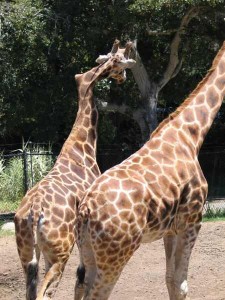tHe BiZaRrE wOrLd oF sCoLiOsIs
Animals with Scoliosis
Just like people, animal can exhibit scoliosis—even house pets. The images below show regular house cats that just happen to have scoliosis. In fact, the image on the right is from a pet rescue website and they note that Scoli (aptly named) is inhibited in no way. Much like humans, animals with scoliosis will experience little to no pain or discomfort. The body will find ways to adapt to changes quite rapidly.

Here are two different dogs with scoliosis. As you can see from the picture, the dog on the right suffers from severe scoliosis and compromised organ function.

Scoliosis presents in a very unusual way in snakes. As you can see from the image below, the scoliosis has an almost helical structure.
This next pictures shows a giraffe with a sharp scoliosis in its cervical spine.
As you can see from the chart on the left, a giraffe’s cervical spine (neck) contains seven vertebrae–just like a humans–only the giraffe’s are much larger. One giraffe cervical vertebra can be as long as 10 inches.
Rats, are popular animals in the world of research because their genetic makeup is similar to that of humans. One can understand why researchers study scoliosis in rats. Perhaps we are close to discovering what exactly causes scoliosis?
In one an article about whether poor nutrition can cause scoliosis, we discussed how researchers found increased instances of scoliosis within a specific species of fish do to the polluted waters they inhabited.

Spinal abnormalities are commonly seen in horses, possibly because they are so massive it is easier to notice. The swaybacked horse below actually suffers from lumbar lordosis, a condition many people experience.
This horse also has a noticeable scoliosis as you can see from the ridge on it’s back.
Just like human spinal curvatures, not all scoliosis in noticeable at first glance. The image to the left is from a horse saddle fitting website. It takes a trained eye to notice the curvature in this horse’s spine. Subtle curves like this matter because they can affect the fit of the saddle. In this instance, the writers note that a normal saddle would easily fall off this horse.
Then again, some abnormal curvatures of the spine are only discovered after an X-ray or, in the case of the images below, once the animal is dissected or butchered.














